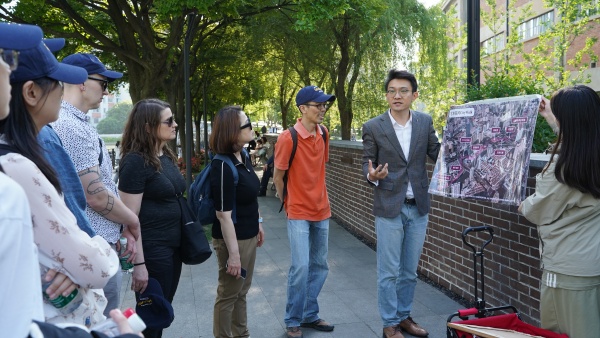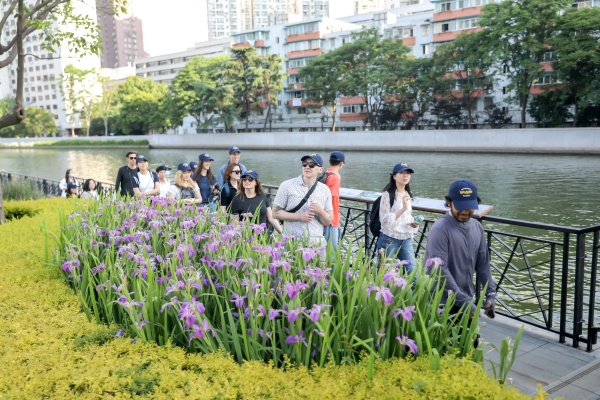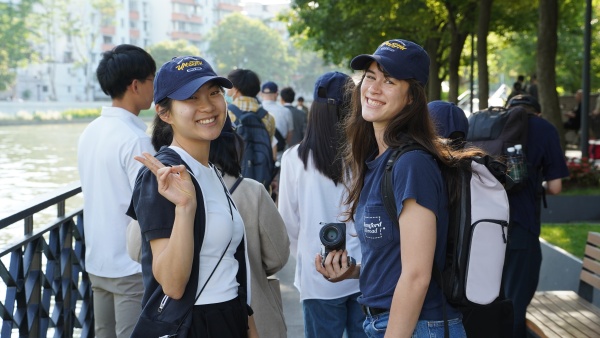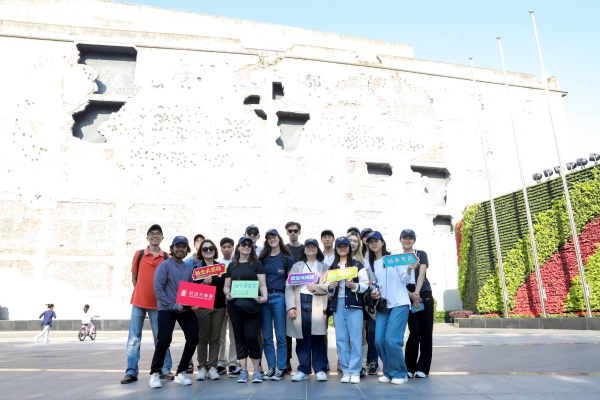“There is no better way to learn about this metropolis, to appreciate its history and its ongoing development, to feel its vibrancy, than walking its tree-lined streets and reading the storied buildings along the way,” said Associate Teaching Professor Kwee-Yan Teh from the University of Michigan-Shanghai Jiao Tong University Joint Institute (UM-SJTU JI, JI hereafter). A Malaysian citizen residing in Shanghai for over a decade, Teh made the above reflection following his citywalk experience in the city last week.
More than 60 students and teachers from JI and the Shanghai High School International Division (SHSID) were guided on a walk along Suzhou Creek in Jing’an District of Shanghai on May 10. The walk is part of a “class beyond classroom” campaign under the 2024 “Urban Classroom” initiative aiming at guiding foreigners in the city to explore the very essence of Shanghai.

Yining Zhu (second from right) introduces heritage sites and cultural landmarks along the creek.
“I believe citywalk offers a window for people to deeply feel the different aspects of a city,” said Yining Zhu, founder and CEO of SimpliCity, a well-established walking tours company that initiated the campaign. “We hope to include more from overseas. We want to show them a real Shanghai, and then when they are back home, they can tell their friends how Shanghai really looks like.”
After opening ceremony of the event, the international attendants kicked off their citywalk journey. They passed old warehouses and factories along the river as the area saw the rise of China’s modern-day finance and industries. Sites also included Sihang Warehouse Battle Memorial, Shenyuli, Butterfly Park and Fotografiska, which, respectively, tells the local revolutionary past, represents the unique Shanghai flavor, showcases an eco-friendly community, and contemporary cultural charm.


JI faculty and students walk along the Suzhou Creek.
The Suzhou Creek, flowing for over a thousand years, gracefully merges with Shanghai’s main Huangpu River, forming Suzhou Bay. Renowned as the birthplace of China’s industrial prowess and the cradle of Shanghai’s financial and cultural heritage, this waterway is integral to the daily lives and emotional landscape of its residents. Covering 4.2 square kilometers in the Jing’an district, Suzhou Bay features a 6.3-kilometer waterfront, connecting 500,000 square meters of historic structures, 17 distinct neighborhoods, and 170 cultural and tourism sites, including museums and art galleries. Serving as a central hub for water vitality, it seamlessly blends Eastern and Western elements along its banks.
“We thoroughly enjoyed the entire tour. Personally, the factory museum stood out as a real highlight for me, given my fascination with history. Learning about the way the specific history of this building in Shanghai connects to the broader context of the start of World War Two was truly great. I also enjoyed learning about the transformation of the creek in recent years. Finally, concluding with a visit to the traditional communal living neighborhood was a fantastic glimpse into the life of the city,” said Matthew Noble-Olson, a JI visiting scholar from the University of Michigan.
His views were echoed by Niladri Saha Saccha, a JI undergraduate student from Bangladesh who visited the area for the first time, “It’s pretty great. It’s different from the typical Shanghai, which, in general understanding, is a very modern city. But this part actually brings us to the old architecture.”

Group photo of JI attendants of the walk





